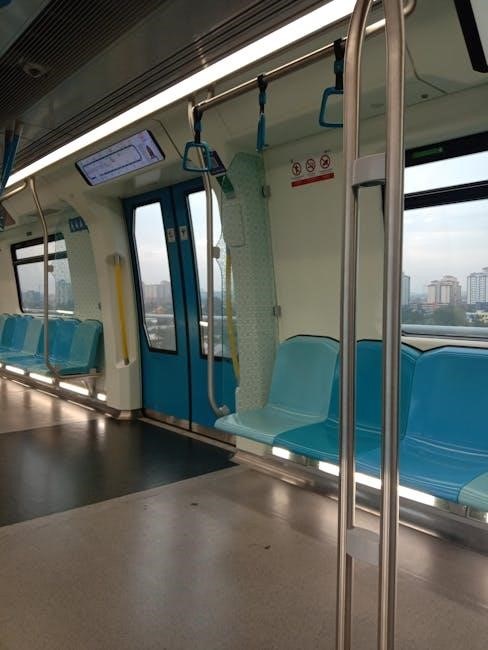A linear guide rail system is a machine element enabling smooth, precise motion in straight lines, ideal for heavy loads and industrial applications, using rolling bearings for low friction.
1.1 Overview of Linear Guide Rail Systems
Linear guide rail systems are essential components for enabling precise, smooth motion in straight lines, widely used in machinery and automation. They consist of rails and carriages with rolling elements, such as balls or rollers, designed to support heavy loads with minimal friction, ensuring high accuracy and durability in industrial applications.
1.2 Historical Background and Evolution
Linear guide rail systems originated from basic carriage systems, evolving significantly over time. The introduction of ball bearings in the mid-20th century revolutionized their design, enhancing precision and load capacity. Modern systems integrate advanced materials and designs, offering improved durability and versatility, making them indispensable in contemporary machinery and automation technologies.
Components of a Linear Guide Rail System
A linear guide rail system consists of rails, carriages, and rolling elements like balls or rollers. These components work together to enable smooth, precise motion in straight lines.
2.1 Rails: Types and Materials
Linear guide rails are available in square or round profiles, made from materials like steel or aluminum. They are often hardened and coated for durability. Square rails provide higher rigidity, while round rails offer flexibility. Surface treatments enhance resistance to wear and corrosion, ensuring long service life in industrial applications.
2.2 Carriages: Design and Functionality
Carriages are designed to slide along the rail, incorporating rolling elements like balls or rollers for smooth motion. They are typically made of durable materials such as steel or aluminum, with hardened surfaces for extended life. The carriage’s design ensures precise alignment, load distribution, and minimal friction, enabling efficient and reliable operation in various applications.
2.3 Rolling Elements: Balls vs. Rollers
Rolling elements, such as balls or rollers, are critical for smooth motion in linear guide systems. Balls offer low friction and high precision, ideal for high-speed applications. Rollers, particularly cylindrical ones, provide higher load capacity but may introduce more friction. The choice depends on load requirements and operational needs.

Types of Linear Guide Rail Systems
Linear guide rail systems are categorized into ball bearing, roller bearing, and slide bushing types, each offering distinct advantages in load capacity, precision, and application suitability.
3.1 Ball Bearing Linear Guides
Ball bearing linear guides utilize recirculating ball bearings for smooth, precise motion, offering high load capacity, low friction, and excellent durability. They are ideal for applications requiring high precision and reliability, commonly used in industrial automation, CNC machines, and robotic systems where consistent performance is essential.
3.2 Roller Bearing Linear Guides
Roller bearing linear guides use cylindrical rollers for higher load capacity and rigidity, making them suitable for heavy-duty applications. They offer excellent torque absorption and are ideal for systems requiring robust performance, though they may have slightly higher friction and noise compared to ball bearings, balancing load handling with smooth operation.
3.3 Slide Bushing Linear Guides
Slide bushing linear guides operate without rolling elements, relying on sliding motion between the bushing and rail. They are cost-effective and suitable for light to medium loads, offering simplicity and ease of installation. These guides are ideal for applications where high precision is not critical, providing a reliable solution for basic linear motion needs with minimal maintenance.

Applications of Linear Guide Rail Systems
Linear guide rail systems are essential in industrial automation, CNC machines, robotics, and material handling, enabling precise and heavy load movements across diverse industries, including medical equipment.
4.1 Industrial Automation and Machinery
Linear guide rail systems are pivotal in industrial automation, enabling precise and smooth motion in machinery. They support heavy loads and maintain high accuracy in applications like machine tools, assembly lines, and robotic arms, ensuring efficient and reliable operation in demanding manufacturing environments.
4.2 CNC Machines and Precision Engineering
Linear guide rail systems are essential in CNC machines for achieving high precision and accuracy. They ensure smooth motion in milling, grinding, and drilling operations, supporting the demanding requirements of precision engineering with minimal friction and maximum reliability, enabling intricate part manufacturing with consistent quality and repeatability in production processes.
4.3 Robotic Systems and Mechatronics
Linear guide rail systems play a crucial role in robotic systems and mechatronics by enabling precise, smooth, and consistent motion. They support high load capacity and low friction, making them ideal for robotic arms and automated systems that require reliable and accurate movement in industrial and advanced manufacturing environments, ensuring optimal performance and efficiency.
4.4 Material Handling and Conveyor Systems
Linear guide rail systems are essential in material handling and conveyor systems, ensuring smooth and consistent workflows. They facilitate precise movement of goods and components, handling heavy loads efficiently. Their durability and low friction characteristics make them ideal for demanding environments, such as warehouses and logistics systems, enhancing overall operational efficiency and reliability.

Selection Criteria for Linear Guide Rail Systems
Selecting linear guide rail systems involves evaluating load capacity, precision, speed, and environmental conditions to ensure optimal performance and longevity in specific applications.
5.1 Load Capacity and Life Calculation
Load capacity and life calculation are critical for selecting linear guide rail systems. Static, dynamic, and moment loads must be evaluated to ensure the system can handle the required forces. Travel life and basic load ratings are key factors for determining longevity and reliability in industrial applications, ensuring optimal performance under specified conditions.
5.2 Precision and Repeatability Requirements
Precision and repeatability are vital for linear guide rail systems, ensuring accurate positioning and consistent performance. Factors like bearing type, rail geometry, and system alignment significantly influence these requirements. High-precision applications demand minimal positional deviation, while repeatability ensures consistent motion over time, making it essential for industrial automation, CNC machines, and robotic systems where exact movements are critical.
5.3 Speed and Acceleration Constraints
Speed and acceleration constraints in linear guide rail systems depend on factors like bearing type, load, and application. High-speed systems require low-mass components and optimized lubrication to minimize wear. Acceleration limits prevent excessive force and ensure smooth operation, crucial for maintaining system stability and performance in dynamic environments, such as robotic and high-speed automation applications.
5.4 Environmental and Operating Conditions
Environmental and operating conditions significantly impact linear guide rail systems. Factors like temperature, humidity, dust, and chemicals can affect performance and lifespan. Proper material selection and protective coatings are essential to ensure durability. Operating in harsh environments requires careful consideration to maintain reliability and prevent premature wear, ensuring optimal functionality over time.

Installation and Maintenance Tips
Proper alignment and precise mounting techniques are crucial for linear guide rail system installation. Regular lubrication and thorough cleaning of rails and carriages ensure optimal performance and longevity.
6.1 Proper Alignment and Mounting Techniques
Proper alignment is critical for optimal performance of linear guide rail systems. Ensure rails are parallel and securely fastened to the machine frame using appropriate fasteners. Use shims or adjustment screws to achieve precise alignment, and verify with a laser alignment system if necessary. Always follow manufacturer guidelines for mounting to prevent misalignment and ensure smooth operation.
6.2 Lubrication and Maintenance Schedules
Regular lubrication is essential for extending the life of linear guide rail systems. Use high-quality grease or oil suitable for the system’s load and operating conditions. Inspect the rails and carriages periodically for debris and wear. Clean and reapply lubricant according to the manufacturer’s schedule to maintain smooth motion and prevent corrosion or premature wear.

Advantages and Limitations
Linear guide rail systems offer high precision, load capacity, and smooth motion, making them ideal for heavy-duty applications. However, they can be bulky and heavy, limiting space efficiency in compact designs.
7.1 High Precision and Load Capacity
Linear guide rail systems are engineered to provide exceptional precision and load-bearing capabilities, making them suitable for heavy-duty applications. Their robust design ensures consistent performance under high stress, maintaining accuracy and reliability. This makes them ideal for industrial machinery and precision engineering, where both strength and exact positioning are critical.
7.2 Low Friction and Smooth Motion
Linear guide rail systems are designed to minimize friction, enabling smooth and consistent motion. Utilizing high-quality rolling elements, these systems reduce operational vibrations and noise, ensuring precise control. Ideal for applications requiring steady movement, they maintain performance under varying loads, making them essential in industrial and precision machinery.
7.3 Space and Weight Limitations
Linear guide rail systems, despite their robustness, often face constraints in compact spaces and weight-sensitive applications. Innovations in design and materials aim to reduce size and weight without compromising load capacity or precision, addressing these limitations while maintaining performance.
Future Trends and Innovations
Future trends include integration with smart technologies, development of lightweight materials, and miniaturization of designs, enhancing performance, efficiency, and applicability across various industries.
8.1 Integration with Smart Technologies
Linear guide rail systems are increasingly integrating with smart technologies like sensors and IoT devices. This enables real-time monitoring of performance, predictive maintenance, and optimized motion control. Such advancements enhance operational efficiency, reduce downtime, and improve overall system reliability in industrial automation and robotics. These innovations are reshaping the future of linear motion systems.
8;2 Development of New Materials
The development of new materials, such as advanced stainless steel and composite components, enhances the durability and performance of linear guide rail systems. These materials improve resistance to corrosion, reduce weight, and increase load capacity. Innovations in self-lubricating polymers and coatings further extend service life and reduce maintenance needs in demanding environments.
8.3 Miniaturization and Compact Designs
The trend toward miniaturization in linear guide rail systems enables space-saving designs without compromising performance. Compact rails and carriages reduce weight and footprint, improving efficiency in robotics and medical devices; Advances in engineering allow for smaller, precise systems that maintain high load capacity and reliability in tight spaces.

Case Studies and Real-World Applications
Linear guide rail systems are widely used in automotive manufacturing, aerospace engineering, and medical devices, enhancing precision and reliability in industrial and high-tech applications.
9.1 Automotive Industry Applications
Linear guide rail systems are essential in automotive manufacturing, enabling precise movement of heavy components. They are used in assembly lines, robotic systems, and material handling. Their high load capacity and smooth operation make them critical for efficient vehicle production, ensuring reliability and accuracy in various automotive applications.
9.2 Aerospace and Defense Solutions
Linear guide rail systems play a crucial role in aerospace and defense, enabling precise motion in aircraft, satellites, and defense equipment. They are used in precision machinery, robotic systems, and deployment mechanisms, ensuring high reliability and durability in demanding environments while maintaining accuracy and load capacity for critical operations.
9.3 Medical and Laboratory Equipment
Linear guide rail systems are integral to medical and laboratory equipment, ensuring precise motion in patient tables, robotic-assisted surgical systems, and lab automation. Their smooth operation and high reliability are critical for accurate diagnostics, sample handling, and microscopic adjustments, contributing to advancements in healthcare and research efficiency.

Troubleshooting Common Issues
Linear guide rail systems often face issues like misalignment, noise, and wear due to contamination or improper lubrication. Regular inspection and maintenance are essential for smooth operation and longevity.
10.1 Alignment and Parallelism Problems
Alignment issues in linear guide rail systems often arise from improper installation or uneven mounting surfaces. Thermal expansion and manufacturing tolerances can also cause misalignment, leading to reduced performance and wear. Proper shimming and alignment tools, such as laser alignment devices, are essential for ensuring rails remain parallel and carriages move smoothly. Regular inspections are critical to prevent operational disruptions.
10.2 Noise and Vibration Reduction
Noise and vibration in linear guide rail systems are often caused by improper lubrication, misalignment, or uneven surfaces. Regular lubrication with high-quality grease and proper alignment during installation can mitigate these issues. Using vibration-dampening pads and ensuring routine maintenance checks are crucial for reducing operational noise and ensuring smoother operation for optimal performance.
10.3 Wear and Tear Prevention
Preventing wear and tear in linear guide rail systems involves proper alignment during installation, regular lubrication, and using protective covers to shield from contaminants. Ensuring even load distribution and avoiding excessive speeds can also minimize wear. Periodic inspections and timely replacement of worn components further extend the system’s lifespan and maintain optimal performance over time.
Linear guide rail systems are essential for precise, smooth motion in various industrial applications, offering high load capacity and durability, making them indispensable in modern machinery and automation solutions.
11.1 Summary of Key Points
Linear guide rail systems provide precise, smooth motion with high load capacity and low friction, essential for industrial automation, CNC machines, and robotic systems, ensuring durability and efficiency in various applications through advanced materials and designs.



